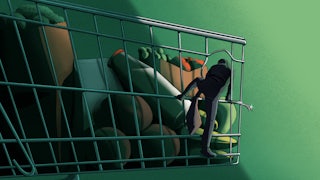Torching your own reputation is usually a onetime engagement. Credibility is finite, and once it’s gone, there is not much left to burn. A reporter who got their sources mixed up once will surprise no one next time they bungle a story; a writer who spreads conspiracy theories is soon known as a crank.
Those rules have somehow not held true for the writer Naomi Wolf. A notable feature of her career has been her ability to repeat the act of self-immolation over and over, singeing others along the way. In the first year of the pandemic, Wolf reliably drew fresh surprise and dismay when she made outlandish claims about the tyranny of public health measures and the dangers of vaccines. Each time that she declared, usually via Twitter, that Anthony Fauci was Satan, or that children who wore masks had lost the ability to smile, that the vaccines were a “software platform that can receive uploads,” or that she had uncovered a plot by Apple “to deliver vaccines [with] nanopatticles [sic] that let you travel back in time,” ripples of consternation followed. Was this really the same Naomi Wolf, the author of a widely read feminist treatise, The Beauty Myth; a longtime contributor to the liberal newspaper The Guardian; a familiar face on MSNBC—a fixture in liberal media since the 1990s? What had happened to her?

These questions proved remarkably durable. The latest Naomi Wolf development was a frequent spectacle on Twitter, and the subject of a steady drip of think pieces. “A Modern Feminist Classic Changed My Life. Was it Actually Garbage?” Rebecca Onion asked of The Beauty Myth in Slate, in March 2021. A few months later, Business Insider documented “Naomi Wolf’s Slide from Feminist, Democratic Party Icon to the ‘Conspiracist Whirlpool,’” and this magazine contemplated “The Madness of Naomi Wolf” in June that year, after Twitter suspended her account. The fascination persisted perhaps because Wolf was herself such a rich subject: her claims so haphazardly, deliciously laced with obvious errors and misapprehensions (the nanoparticles story turned out to be based on a conversation she overheard in a restaurant about the Apple Watch); the targets of her outrage so bizarre (as when she tweeted “No! No!!” at a photo of a teddy bear wearing a mask).
Collateral damage in the saga was the writer Naomi Klein, who kept getting mistaken for Wolf in the fog of online indignation. People stirred up by Wolf’s tweets would start yelling at Klein, wondering what had scrambled her political commitments, how the author of No Logo and The Shock Doctrine, who had devoted her career to studying the excesses of corporate power, could have come to this. (And perhaps the fact that Klein’s reputation was intact perpetuated the sense, essential to a Twitter pile-on, that someone’s good name was still at stake.) People were confusing the two Naomis so often that a subset of jokes began to do the rounds: “The real victim in all this here is Naomi Klein,” “Thoughts and prayers to Naomi Klein,” and so on. Someone even composed a mnemonic that went: “If the Naomi be Klein / you’re doing just fine / If the Naomi be Wolf / Oh, buddy. Ooooof.”
Klein for her part kept a dignified silence as all this unfolded, limiting herself to the occasional wry comment at moments when “Other Naomi,” as she came to think of her, had said something particularly disastrous. She changed her Twitter bio to “not that Naomi,” and issued a “periodic reminder to keep your Naomis straight.” But privately Klein found the mix-ups more disturbing than she let on. In her new book, Doppelganger, she writes of her compulsion to keep an eye on Wolf’s antics, at first as a defense mechanism, in order to steel herself for the blowback that was to come, but later out of a strange curiosity. She found herself watching Wolf’s appearances on Tucker Carlson Tonight, listening to her guest spots on Steve Bannon’s podcast, transfixed by the front-facing video Wolf released on Why Vaccine Passports Equal Slavery Forever, and searching these appearances for clues. What had happened to Naomi Wolf? And what had the public confusion between the two of them—the encroachment of one Naomi on the other—done to Klein’s own sense of self?
This story of mistaken identity would on its own be gripping and revealing enough, both as a psychological study and for its explorations of the double in art and history, the disorienting effects of social media, and the queasy feeling of looking into a distorted mirror. But the larger subject of Doppelganger turns out to be a far more complex and consequential confusion: Its guiding question is how so many people have in recent years broken with conventional left-right political affiliations and a shared understanding of reality, and crossed over into the “Mirror World,” a realm of “uncanny people” and “upside-down politics” where facts are arbitrary and people who still advertise themselves as liberals can make common cause with conspiracists and fascists. The Naomi-Naomi story is more than a generous and capacious reflection on being taken for someone else; it is also the frame for a uniquely astute account of the scrambled political formations that have come out of the pandemic.
A doppelgänger is a double, a person who appears so similar to another that they could easily stand in for them, maybe even take over their life. “The idea that two strangers can be indistinguishable from each other taps into the precariousness at the core of identity,” Klein writes. In Philip Roth’s novel Operation Shylock, a rogue double makes a mockery of Roth’s career, mimicking his lifestyle and parodying the themes of his work, to the point that nothing the real Roth can say or do appears authentic or holds a stable meaning. In Dante Gabriel Rossetti’s painting How They Met Themselves, the two young lovers who encounter their doubles in a dark forest simply cannot contemplate these identical copies of themselves: The man draws his sword, the woman faints.
Naomi Wolf does not in fact resemble Naomi Klein in appearance or personality particularly closely, but from the distance of a byline or a Twitter handle, they were, for many readers, similar enough. Both Naomis, Klein notes, are authors of “big-idea books” who started out in the 1990s, Wolf with The Beauty Myth in 1990, Klein with No Logo in 1999; both have “brown hair that sometimes goes blond from over-highlighting”; both are Jewish. Their name is “just uncommon enough that the first Naomi a person became aware of tended to imprint herself in their mind as a kind of universal Naomi.”
Earlier in their careers, mix-ups between the two writers were less common. They had each carved out a distinctive beat, with Wolf on feminism and Klein on corporate exploitation. The problems began, Klein believes, around 2007, when Wolf began to write more broadly on politics, and, at least on the surface, they appeared to be covering similar subjects. Wolf’s book The End of America focused on elite institutions, as Klein had in The Shock Doctrine, though with a very different approach and tone; Klein wrote about the Green New Deal, and so did Wolf, though with added “special conspiracy twists.” Klein reported on “the dangers of geoengineering as a response to the climate crisis” around the same time that Wolf was “busily speculating on social media about chemical cloudseeding and covert mass poisonings.” Wolf’s writing could be read as a funhouse mirror version of Klein’s work on concentrated power and its ravages, overlaid with a film of overheated theories and urgent warnings. Telling these two modes apart, however, means recognizing the precision of one versus the hyperbole of the other, seeing the difference between rigorous use of sources versus panicky leaps in logic. It’s not hard to imagine how the two versions might easily blur in the mind of a casual reader. Klein is refreshingly, resolutely anti-conspiratorial in her summary of all this. She doesn’t see the convergence of her themes and Other Naomi’s as remotely intentional, she dryly remarks. “Just deeply unfortunate.”
At first, Klein responded to the mix-ups by trying to ignore them. But as Wolf’s rhetoric escalated in 2021, Klein paid closer attention. After Wolf’s video on Why Vaccine Passports Equal Slavery Forever, she hyped fears of a “CCP-style social credit score system.” She appeared “on Fox seven times in less than two months” and became a regular guest on Steve Bannon’s podcast War Room, weighing in on vaccines at first, but then on all manner of political news. She rallied for Five Freedoms, which she listed as “No Vaccine Passports, No Mask Mandates, No Emergency Law, Open Schools Up 100%,” and “Freedom of commerce, worship, petition.” And though Klein notes that Wolf is “prone to exaggerating her own influence,” she amassed a large, engaged following and “seemingly helped inspire large numbers to take to the streets in rebellion against an almost wholly hallucinated ‘tyranny.’”
As much as Klein wanted to keep a distance, she felt pulled into “a quest to understand what messages, secrets, and forebodings” the appearance of her double offered. She began to spend evenings watching everything she “could find about doubles and doppelgangers, from Carl Jung to Ursula K. Le Guin; Fyodor Dostoyevsky to Jordan Peele.” And of course she developed an intense psychic and intellectual involvement with Wolf’s Twitter presence. Some of the most charming moments in the book are recognizable domestic skirmishes over unhealthy social media use: as when Klein saunters into the kitchen with her laptop, sheepishly asking her husband if she can “just read you this one tweet,” or when she swears to give Wolf-watching a break during a family vacation to Prince Edward Island, only to end up furtively bingeing on episodes of War Room in her car (“a full-blown relapse into my doppelganger’s world”). She develops a level of obsession that might sound like stalking were it not so familiar, were it not in fact the nature—and the entire business model—of social media itself.
It was perhaps also so hard to look away from Other Naomi because of the intense isolation of the period when the confusion reached its crescendo—in a year of stay-at-home orders and social distancing, when platforms like Twitter served as a meager substitute for a richer and wider range of interaction. “Covid had canceled so many of the things that had, for years, told me who I was in the world,” Klein writes.
A planned book tour. A series of lectures. Places where people would come up to me and share what my work meant to them and where I would learn new things from them. I still spoke at all kinds of what we came to call “virtual events.” ... After each event, I would check Twitter to get any kind of confirmation that I had actually reached other humans. And often I would find only her: her outrageous theories, the confusion, the backlash, the wry jokes.
The world was disappearing, and so was I.
Klein had plenty of her own thoughts about the pandemic, and in the early months she reported on how tech companies such as Google and Amazon were profiteering on the crisis, “taking advantage of lockdowns to push a wish list of ‘no touch’ technologies, rapidly rebranding them as ‘Covid-safe.’” Klein foresaw “a grim, AI-enabled vision of a touchless society that would employ far fewer teachers, doctors, and drivers,” that would “accept no cash, and have skeletal mass transit.” Yet she soon began to see “examples of these same trends being cast in far more conspiratorial ways” by figures who went so far as to suggest “maybe the tech companies had planned the whole thing,” or that the virus wasn’t even real, and the pandemic itself was an elaborate hoax. She became wary of appearing to fuel any such claims. “I just couldn’t figure out how to keep talking about how the large tech firms were exploiting the crisis without it being sucked into the whirring conspiracy mill,” Klein writes searchingly. Everything could so easily be turned upside down. “The truth is that I backed off.”
We might expect this to be the point in the story when Klein decides it’s time to stand up and vigorously defend her own identity. Or as one digital strategy consultant tweeted, “Naomi Klein should sue for trademark dilution and brand harm.” But she shrinks from that route, not least because she has long opposed the idea that people should package and market themselves like products; No Logo was, she reminds us, “a treatise against the rise of lifestyle branding.” And in any case, the more one struggles against one’s doppelgänger, insisting, “I will reassert myself as the owner of my ideas, my identity, my name!” the more intensely the two are locked together, fused in a struggle to be the main character.
If there is any lesson to be drawn, at least on a personal level, from this “doppelganger trouble,” it is, Klein concludes, that “we are not as separate from one another as we might think.” The book is in its way a serious effort to bear out that realization, as Klein melds her story willingly with Wolf’s for over 300 pages. Throughout there are conscious acts of recognition, instead of outright rejection. She credits the good in Wolf, “a person who clearly loved language, thought deeply about the inner lives of girls and women, and had a vision for their liberation,” and even acknowledges that Wolf’s success in the 1990s—when Klein, a 20-year-old student, interviewed her for the college newspaper—may have helped her imagine her own future as a writer. Which of them, she wonders, is the double anyway?
The case of Naomi Wolf, however, is a multipart problem. More puzzling than how anyone could mistake her identity is how she could make the claims that she has made, and how she could ally herself with figures like Tucker Carlson, Steve Bannon, and Donald Trump. There’s a story here about the set of forces that guided Wolf specifically toward the conspiratorial fringe, but also a wider story about the swaths of people who have recently made similar journeys. These are the people who over roughly the last five years have gone off the deep end, as it were. “Almost everyone I talk to tells me about people they have lost ‘down the rabbit hole,’” Klein reports, “parents, siblings, best friends, as well as formerly trusted intellectuals and commentators.”
People who could once be expected to trust the same institutions and espouse similar values may now differ vastly. Klein recounts the bewildering experience of canvassing door to door in the district where her husband was running for office in British Columbia. She is hopeful when she approaches a house with solar panels on the roof and an electric car in the driveway. But nothing goes as expected. Although the woman who opens the door has long voted for the socialist New Democratic Party, she has soured on the party, which she believes has been taken over by “the globalists,” and she is not open to any further discussion. At another house, a woman in yoga pants riffs on “bodily autonomy” and “sovereign citizenship” and her “strong immune system”—all the reasons she opposes vaccines. When Klein’s husband politely reminds the woman of the dangers that immune-compromised people face in unvaccinated communities, she simply states, “I think those people should die.”
To be sure, these encounters are jarring on an interpersonal level. “People who were familiar” have “somehow become alien, leaving us with that unsettled, uncanny feeling,” Klein observes. But they’re also difficult to make sense of politically, seeming to defy traditional forms of left-right identification. One of the strengths of Klein’s book is the clarity with which she traces the composition of the “strange-bedfellow coalitions” that have coalesced since the pandemic, encompassing the traditional right and the conspiratorial hard right, as well as “alternative health subcultures usually associated with the green left,” parents who are angry about school closures (and a range of other culture war issues), and small-business owners badly affected by lockdowns. What is happening here is not a process of political conversion, with onetime leftists defecting to the right—as, say, members of the Old Left did in the 1960s and 1970s to help found the neoconservative movement. Figures like Wolf continue to claim the mantle of liberalism and feminism even as they align with Bannon and Trump and claim that their peers are the ones who have betrayed those commitments; they present their so-called political homelessness as a sign of their integrity.
Borrowing from the scholars William Callison and Quinn Slobodian, Klein calls these new formations “diagonalist”—a term that describes the forging of coalitions that cross traditional left-right divides in unexpected ways. Diagonalists, Callison and Slobodian write,
tend to contest conventional monikers of left and right (while generally arcing toward far-right beliefs), to express ambivalence if not cynicism toward parliamentary politics, and to blend convictions about holism and even spirituality with a dogged discourse of individual liberties. At the extreme end, diagonal movements share a conviction that all power is conspiracy.
The unlikeliness of the alliance is an important element of diagonalism. This is why, Klein points out, Tucker Carlson tells Wolf with an air of self-flattery, “I never thought I would be talking to you except in a debate format.” And why Wolf takes pride in telling Bannon: “I spent years thinking you were the devil, no disrespect.” These coy performances of open-mindedness imply that they’ve been thrust together by the unreasonableness of their former comrades, united in a more urgent cause than anyone in mainstream politics is willing to recognize. In such performances, they can imagine themselves reaching magnanimously across the aisle, in contrast to a cancel culture and purity test–obsessed left.
For all the cries of “what happened to Naomi Wolf?” the forces that ushered her into this ghoulish lineup are not difficult to identify. Wolf had suffered a series of public humiliations in the years leading up to the pandemic. She had toyed with a number of conspiracies—such as that the filmed killings of Western captives by the Islamic State were a hoax; that the U.S. government had a plan to spread Ebola in order to justify tyrannical lockdowns—but none had really stuck. She had stumbled into errors, which had been exposed in a devastatingly public manner—the worst case being when a BBC interviewer revealed that a central claim in her book Outrages rested on her misunderstanding of court records, and her publisher pulped the book in 2019. Wolf had lost her traditional audience; there was no longer a place for her in the market for reputable books about big ideas. Exile gave her every incentive to press further into the world of conspiracies, where her banishment from the liberal media became a badge of honor, and when the pandemic hit, she struck gold. Wolf didn’t “lose it,” Klein points out; on the other side of humiliation, she quickly found a huge and accepting—even adoring—audience.
If a combination of Very Online mishaps and career potholes made Wolf a diagonalist, the forces that forged the larger diagonalist coalition are more consequential. The pandemic arrived in 2020 atop a series of “other long-repressed emergencies,” from climate crisis to soaring levels of inequality to mass incarceration to the increasingly extortionate and exploitative nature of a threadbare, private health care system. In the neoliberal era, individuals are forced to assume sole responsibility for navigating “every hardship and every difficulty—from poverty to student debt to home eviction to drug addiction.” When the pandemic exacerbated these hardships, it was an uphill battle to build solidarity and convince people to support collective solutions. After a lifetime of being told they were on their own, “a subset of the population” doubled down on individualism. It does not, now, seem surprising to Klein that they essentially said, “Fuck you: we won’t mask or jab or stay home to protect people we have already chosen not to see.” Nor that they went looking for pundits and political leaders who reinforced their worldview.
Among that subset, Klein noticed, people who worked broadly in wellness or physical fitness featured prominently: “trainers, yoga teachers, CrossFit instructors, masseuses, mixed martial artists, chiropractors, lactation consultants, doulas, nutritionists, herbalists, menopause coaches, and certified juice therapists” had a tendency to cross into the Mirror World. Like the woman in the yoga pants who thought immune-compromised people should die, people enmeshed in wellness culture were apt to morph into anti-vaccine and anti-mask influencers. The Center for Countering Digital Hate’s “Disinformation Dozen”—a list of the 12 people responsible for nearly two-thirds of all bogus claims about Covid and vaccines—included a chiropractor, three different osteopaths, and the blogger behind Health Nut News. (One might also look at Representative Marjorie Taylor Greene, who has spoken of “vaccine Nazis” and used to own a CrossFit gym.)
Many wellness workers were hit hard by stay-at-home orders and social distancing recommendations because their jobs required in-person contact. But, as Klein argues, the underlying tenets of wellness culture also set the stage for a paranoid individualism: Neoliberal wellness culture’s message “that individuals must take charge over their own bodies as their primary sites of influence, control, and competitive edge” and “that those who don’t exercise that control deserve what they get” has turned out to be “all too compatible with far-right notions of natural hierarchies, genetic superiority, and disposable people.”
A collection of resentments and fears isn’t enough on its own to solidify a political formation. Instead, as Klein traces, the right actively courted people who felt newly angry and abandoned in 2020. On War Room, Bannon marveled at “all these moms who are listening to Naomi Wolf.” He made her a regular on his show, sensing, Klein writes, that there was political power to be gained by appealing to “pissed-off, mostly white suburban moms—nerves frayed from those years of yo-yo remote schooling and closed gyms … done being dismissed and mocked as ‘Karens’ by mean liberals.” For all the preposterousness of so many of Wolf’s public statements, the influence she exerted was real. Meanwhile, the liberal journalists who thought they were watching a meltdown every time she tweeted focused, perhaps too much, on how she had embarrassed herself, or had traduced us, the once-appreciative readers of The Beauty Myth, and not enough on the new friendships she was making.
Doppelganger could have followed the contours of so many stories of doubles and stolen identities and evil twins, in which the goal is chiefly to unmask the impostor; with the doppelgänger vanquished, order is restored, and all is well again. Klein is clear that this story is not that simple: Even if we could banish misinformation, we would still be left with a series of social, political, and environmental crises that have gone largely unaddressed in government—hardly a vision of equilibrium. A major reason why the distortions and evasions of the Mirror World have appealed to so many people is that the baseline of political health in the United States today is so very low.
“Doppelganger stories are never only about them,” Klein writes. “They are always also about us.” She questions whether those of us on this side of the mirror have done enough to present a thoroughgoing plan to address these crises, and to win support for that plan among people who are feeling the effects in direct and indirect ways. “And does that plan feel credible, rooted in action—or does it seem like more blah, blah, blah?” For, while liberal politicians might gladly pose for photos at protests or profess their commitment to equality, they have a long track record of broken promises: of “using words as intended, yet with no intention of acting on them.” The right, meanwhile, does have a plan, or at least a series of calls to action that, histrionic and facile as they might seem, resemble a plan: “The plan is to push ‘Five Freedoms’ and ‘no mask’ laws wherever you live. The plan is to barge into your local school board meeting, accuse its members of being Nazis, and get elected to take their place.… The plan is to get you to send them money, to join their wars,” Klein recaps.
A frequent refrain on War Room is “Action! Action! Action!” Even though many of the pleasures of Doppelganger lie in its psychological acuity, the book is not content to be a meditation on doubleness; the only way to get out of the Mirror World is to do things. If figures like Bannon and Wolf are selling self-righteous individualism, the left must work on bringing people together and building solidarity. Attempts to take collective action—“to unionize our workplaces, or halt evictions, or free political prisoners, or build alternatives to policing, or stop a pipeline, or get an insurgent candidate elected”—won’t dissolve deep divisions in society, but they do help to balance them with “the recognition of shared interests” and, sometimes, the rush of shared power.
The focus of Doppelganger is not an individual but, as in the expansive visions of Klein’s other books, a system that fractures society and drives people apart. This framing is the least unkind and least self-obsessed way possible to approach a book about seeing a portion of your public persona swept away in someone else’s career maelstrom. And yet it’s hard to imagine this work without the bizarrely distinctive figure of Naomi Wolf at the center of it: not only because of the perverse flair she has shown for invention and self-reinvention, but because we see her here at a moment of transformation that is now almost complete, and will be crucial to understanding where the politics she represents are heading. She is no longer really a warped reflection of the liberal media or its values, and, as the diagonalist formation solidifies, she is less obviously a double of Naomi Klein or anyone else. I would be surprised if anyone mistakes one for the other in future.






